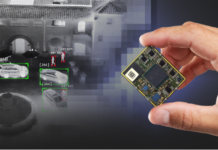
As a part of its efforts to place a sharper emphasis on industrial applications, GE’s Industrial Solutions has introduced its new Hornet industrial voltage regulators. The product family, which consists of 15 non-isolated DC-DC converters, also offers the high power density often demanded by energy-hungry and space-constrained industrial applications.
With the rise of the Industrial Internet and the Internet of Things (IoT), the industrial sector is evolving into a more advanced, automated space. As this happens, engineers and designers are constantly fighting the battle between integrating as many features as possible into their end products and remaining conscious not to create a solution that is too large for its own good.
“Our new Hornet voltage regulators give back valuable space in the design process by combining high power capabilities in a minimal footprint to deliver leading power densities. This, in turn, allows for additional capabilities and components to be incorporated into end designs,” said Vesa Jokitulppo, senior product manager, GE’s Industrial Solutions. “In addition, because our Hornet units have been engineered to provide complete voltage regulation in a single module, users are able to integrate them quickly and easily into their power train designs—speeding time to market for their end products.”
GE’s Hornet family of board-mounted DC-DC converters range in maximum power capability from 11 to 108 watts, and they provide efficiency levels ranging from 92-97 percent, depending on the model. The power modules convert standard bus voltages of 12 and 24 volts to the precise load level required to power components such as memory, processors, actuators and other embedded electronics. Of the 15 total Hornet solutions, 13 step down power from 12 or 24 volts to a lower required voltage, and the remaining two units boost the voltage to a higher (16-34 or 32-54) voltage. The product family offers versatility to meet the unique power conversion requirements of various industrial applications.
“The powerful processors and field-programmable gate arrays commonly found in modern industrial applications require highly accurate voltage regulation to help ensure continuous, high-performance operation,” Jokitulppo continued. “Our Hornet voltage regulators provide the precision these applications demand as well as the transient response needed to accommodate demanding industrial loads.”
The Hornet voltage regulators also provide the ruggedness desired and often needed in demanding industrial applications such as automation equipment, factories and manufacturing, water treatment facilities, energy exploration and refineries—to name a few. The units are well-suited for conformal-coated customer boards, a process that helps to mitigate challenges associated with corrosive (salt mist), volatile and dirty environments. The modules also feature a high operating ambient temperature range, with 11 of the 15 modules able to operate between minus 40 to 105 C and the remaining four units from minus 40 to 85 C. In addition, the Hornet voltage regulators enable high reliability having completed rigorous testing to help ensure continuous operation in challenging environmental conditions. These tests included:
1,000-hour high-temperature operating bias.
1,000-hour 85 degrees C, 85-percent relative humidity and bias.
Thermal cycling of 700 cycles at minus 40 to 125 degrees C.
Adding to their value in rugged, hazardous and uncontrollable environments, the Hornet units meet MIL Std. 810F qualification standards for shock and vibration, and they offer planned availability for upwards of 10 years—making the DC-DC converters well-suited for use in long life cycle and remote applications. Other key applications for GE’s Hornet voltage regulators include building and process controls systems and automation equipment, control cabinets and rooms, conveying equipment, vending machines, material handling and packaging equipment, chemical processing plants, HVAC (heating, ventilating and air conditioning) equipment, machinery and irrigation technology.


















